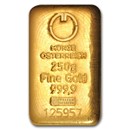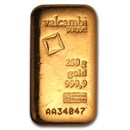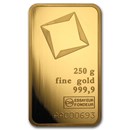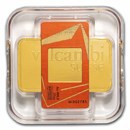250 gram Gold Bars & Rounds
About 250-Gram Gold Bars And Rounds
250-gram gold bars and rounds are popular ways to invest in physical gold. While many are familiar with the 1 kilogram gold bar, 250 gram options often present a more approachable way to invest in gold, offering a more affordable price.A 250-gram gold bar typically contains 8.03858 troy ounces of pure gold, 99.99% or higher in fineness. These bars are usually produced by accredited refiners and are stamped with the refiner's name, weight, and purity. They are commonly sold in plastic cases or assay cards to protect them from damage and ensure authenticity.
On the other hand, gold rounds are similar to coins in appearance, but they are not legal tender. Private mints usually produce them, and come in various sizes and designs. A 250-gram gold round typically contains 8.03858 troy ounces of pure gold, just like a 250-gram gold bar.
The main difference between gold bars and gold rounds is their appearance and how they are produced. Accredited refiners typically have gold bars that are uniform in shape and size, while gold rounds can come in different shapes and designs and are usually made by private mints. Whether you buy 250-gram gold bars or 250-gram rounds, they both have value based on the price of gold per gram.
Both 250-gram gold bars and gold rounds can be a good choice when investing in gold. Regardless of which you choose, both gold rounds and bars diversify portfolios from the U.S. dollar. However, for investors searching for gold in a smaller format, APMEX's 1 oz TEP Gold Bar can be a great choice. It's essential to consider your overall investment goals, to buy from reputable dealers, and ensure the purity and authenticity of the gold before making a purchase.
Why Do Investors Like 250-Gram Gold Bars?
There are several reasons why investors like 250-gram gold bars:
- High Purity: 250-gram gold bars are typically produced by accredited refiners and are stamped with the refiner's name, weight, and purity. They are usually 99.99% pure or higher, which means they have a high gold content and are valued for their purity.
- Cost-Effective: 250-gram gold bars are more cost-effective than smaller bars or coins because they have a lower premium over the spot price of gold. This means that investors can buy more gold for their money.
- Easy to Store: 250-gram gold bars are compact and easy to store. They can be stacked in a safe or safety deposit box, and their uniform shape makes them easy to handle.
- Liquidity: 250-gram gold bars are highly liquid so they can be easily bought and sold on the open market. This makes them popular for investors who want to buy and sell gold quickly and easily.
- Diversification: Adding 250-gram gold bars to a diversified investment portfolio can help to reduce overall risk. Gold has historically been a safe-haven asset that can hedge against inflation, currency devaluation, and economic instability.
For those who want to further maximize their investment, it's worth also considering 1 kilo Gold Bars. Investors may consider these for their often lower premiums per ounce, making them more cost-effective for larger investments.
Pros & Cons
Here are some of the pros and cons of investing in gold.Pros:
- Diversification: Gold can help diversify an investment portfolio by reducing overall risk. Gold has historically provided a hedge against inflation, currency devaluation, and economic instability.
- Safe Haven: Gold is often seen as a haven asset, particularly during economic uncertainty. This means that investors may turn to gold during market downturns or periods of high volatility.
- Tangible Asset: Gold is a physical asset that can be held in your hand. Unlike stocks, bonds, or other financial assets, gold is not dependent on the performance of a company or government.
- Inflation Hedge: Gold can serve as a hedge against inflation. When the value of currencies decreases, the price of gold often increases.
Cons:
- Volatility: Like any investment, the price of gold can be volatile and can fluctuate over time. This means that investors may experience significant losses if the price of gold drops.
- No Yield: Gold provides no yield or income, unlike bonds or stocks. This means that investors will not receive regular payments while holding gold.
- Storage Costs: Physical gold requires storage, which can be costly. Investors may need to pay for safe deposit boxes, insurance, or other storage options.
- Market Liquidity: While gold is generally considered a liquid asset, there may be times when gold demand is low, making it difficult to sell.
Check out what other customers are saying.










